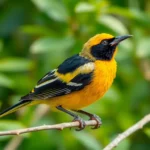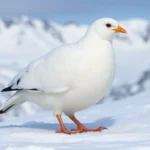We’ve all witnessed that breathtaking moment when a bird plunges from the sky into water with pinpoint precision. Diving birds represent some of nature’s most skilled aquatic hunters, perfectly adapted for life both above and below the surface. These remarkable creatures have evolved specialized features that make them incredibly efficient at catching fish and other marine prey.
From the powerful wings of pelicans to the streamlined bodies of gannets, diving birds showcase extraordinary adaptations that allow them to thrive in aquatic environments. Their hunting techniques range from spectacular high-speed dives to graceful underwater pursuits, each species perfecting its own unique approach to underwater foraging.
Whether you’re a birdwatching enthusiast or simply curious about wildlife, understanding these magnificent creatures reveals fascinating insights into evolution and survival strategies. We’ll explore the diverse industry of diving birds, their hunting methods, and the remarkable adaptations that make them such successful aquatic predators.
What Are Diving Birds?
Diving birds represent a specialized group of avian species that have evolved remarkable abilities to hunt and feed underwater. These aquatic hunters combine aerial flight skills with underwater swimming capabilities to capture fish, crustaceans, and marine invertebrates in their natural habitats.
Physical Adaptations for Underwater Hunting
Streamlined body shapes allow diving birds to cut through water with minimal resistance during underwater pursuits. Their dense bones provide negative buoyancy that helps them dive deeper without expending excessive energy fighting natural flotation.
Specialized feathers create waterproof barriers that keep skin dry while maintaining body temperature in cold aquatic environments. The outer feathers contain microscopic structures that trap air bubbles, forming an insulating layer between the bird’s body and surrounding water.
Powerful leg placement varies among species based on their hunting strategies. Cormorants position their legs toward the rear of their bodies for maximum underwater propulsion, while grebes feature lobed toes that function as natural paddles for precise maneuvering.
Enhanced lung capacity enables extended underwater hunting sessions lasting 30 to 90 seconds depending on the species. Their blood contains higher concentrations of oxygen carrying cells compared to non diving birds, extending their breath holding capabilities significantly.
Sharp, backward facing beaks prevent slippery fish from escaping once captured. Many species feature serrated edges along their bill margins that grip prey securely during rapid underwater movements.
Common Diving Bird Species Worldwide
Cormorants inhabit coastal waters and inland lakes across six continents, with 40 recognized species displaying varied hunting depths from surface feeding to 150 foot dives.
Pelicans demonstrate two distinct hunting approaches: brown pelicans execute spectacular plunge dives from heights of 65 feet, while white pelicans practice cooperative surface feeding in shallow waters.
Gannets and Boobies perform high speed aerial dives reaching velocities of 60 mph before entering water to pursue fish at depths exceeding 50 feet in marine environments.
Grebes excel in underwater swimming with their lobated toes and rear positioned legs, hunting small fish and aquatic insects in freshwater lakes and ponds throughout North America and Europe.
Loons combine powerful underwater propulsion with distinctive calls, diving to depths of 200 feet in northern lakes to capture fish using their dagger like bills.
Kingfishers represent smaller diving specialists that hunt from perches above streams and rivers, executing precise dives to capture minnows and aquatic insects in shallow water habitats.
Types of Diving Techniques
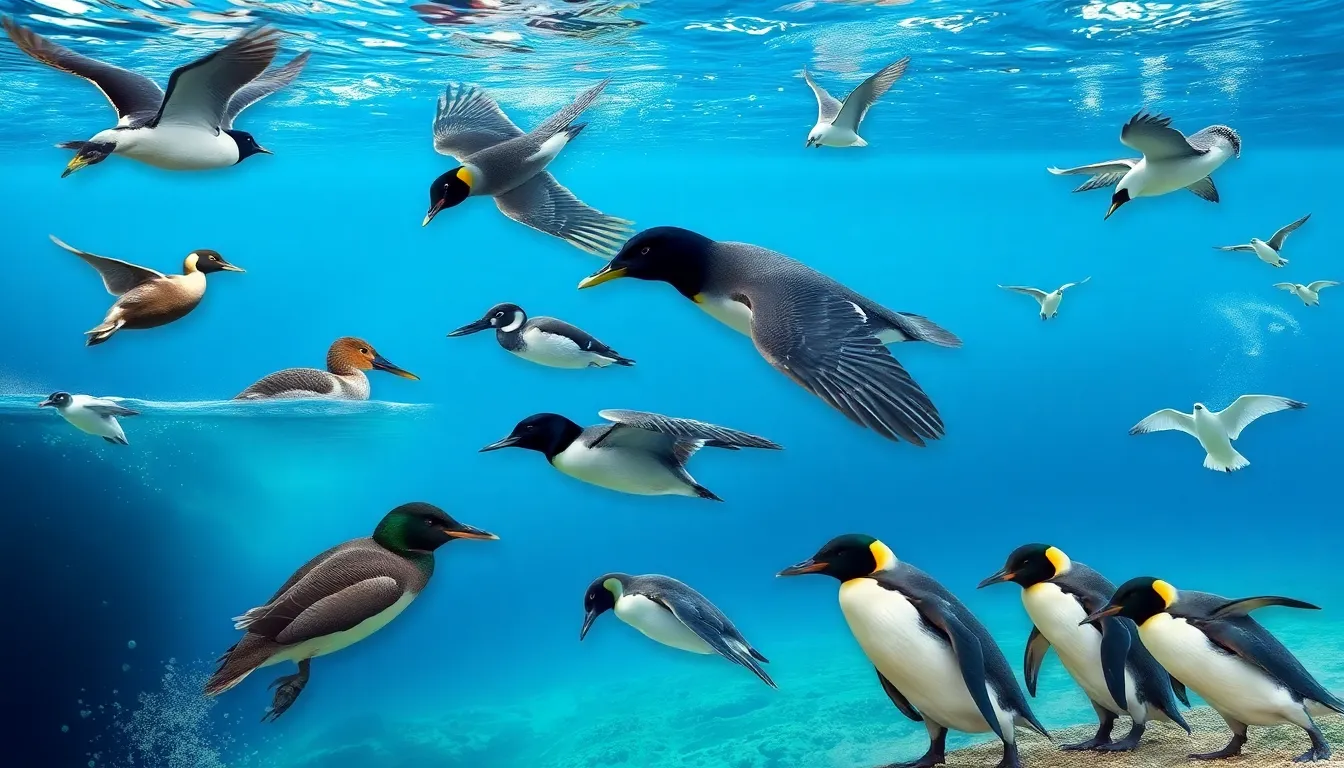
Diving birds employ distinct hunting strategies that vary based on their physical adaptations and prey preferences. We categorize these techniques into two primary methods that showcase the remarkable diversity of underwater hunting approaches.
Surface Diving vs Deep Diving
Surface diving involves birds that feed primarily in shallow waters up to 20 feet deep and typically stay submerged for 10-30 seconds. Dabblers like mallards and teals tip forward to reach aquatic vegetation and invertebrates just below the water surface. Grebes demonstrate intermediate surface diving by propelling themselves 3-6 feet underwater using their lobed toes to chase small fish and crustaceans.
Deep diving specialists descend to depths exceeding 100 feet and remain underwater for 1-4 minutes during hunting expeditions. Loons reach depths of 200 feet while pursuing fish in cold northern lakes. Cormorants dive 25-80 feet deep in both freshwater and marine environments, using their webbed feet for powerful propulsion. Emperor penguins represent the extreme end of deep diving, reaching depths of 1,640 feet during their underwater hunts.
| Species | Maximum Depth | Dive Duration | Primary Prey |
|---|---|---|---|
| Mallards | 3 feet | 5-15 seconds | Aquatic plants |
| Grebes | 6 feet | 10-30 seconds | Small fish |
| Cormorants | 80 feet | 30-70 seconds | Fish |
| Loons | 200 feet | 1-3 minutes | Fish |
| Emperor Penguins | 1,640 feet | 3-22 minutes | Fish, squid |
Pursuit Diving Specialists
Pursuit diving birds actively chase their prey underwater using specialized propulsion methods. Penguins use their flipper-like wings to “fly” through water at speeds reaching 22 mph while hunting krill, fish, and squid. Auks including puffins and murres combine wing-propelled swimming with steering using their webbed feet to capture small schooling fish.
Foot-propelled pursuit divers rely on powerful leg strokes to navigate underwater environments. Grebes position their legs far back on their bodies, creating efficient underwater propulsion while their streamlined profile reduces drag. Cormorants spread their wings slightly for balance while their large webbed feet provide the primary thrust for chasing fish through underwater vegetation and rocky areas.
Wing-propelled specialists sacrifice aerial flight efficiency for underwater maneuverability. Flightless diving birds like steamer ducks use their powerful wings exclusively for underwater propulsion, reaching speeds of 8 mph beneath the surface. Diving petrels represent a compromise adaptation, maintaining limited flight capability while using modified wings for effective underwater pursuit of small fish and zooplankton.
Notable Diving Bird Species
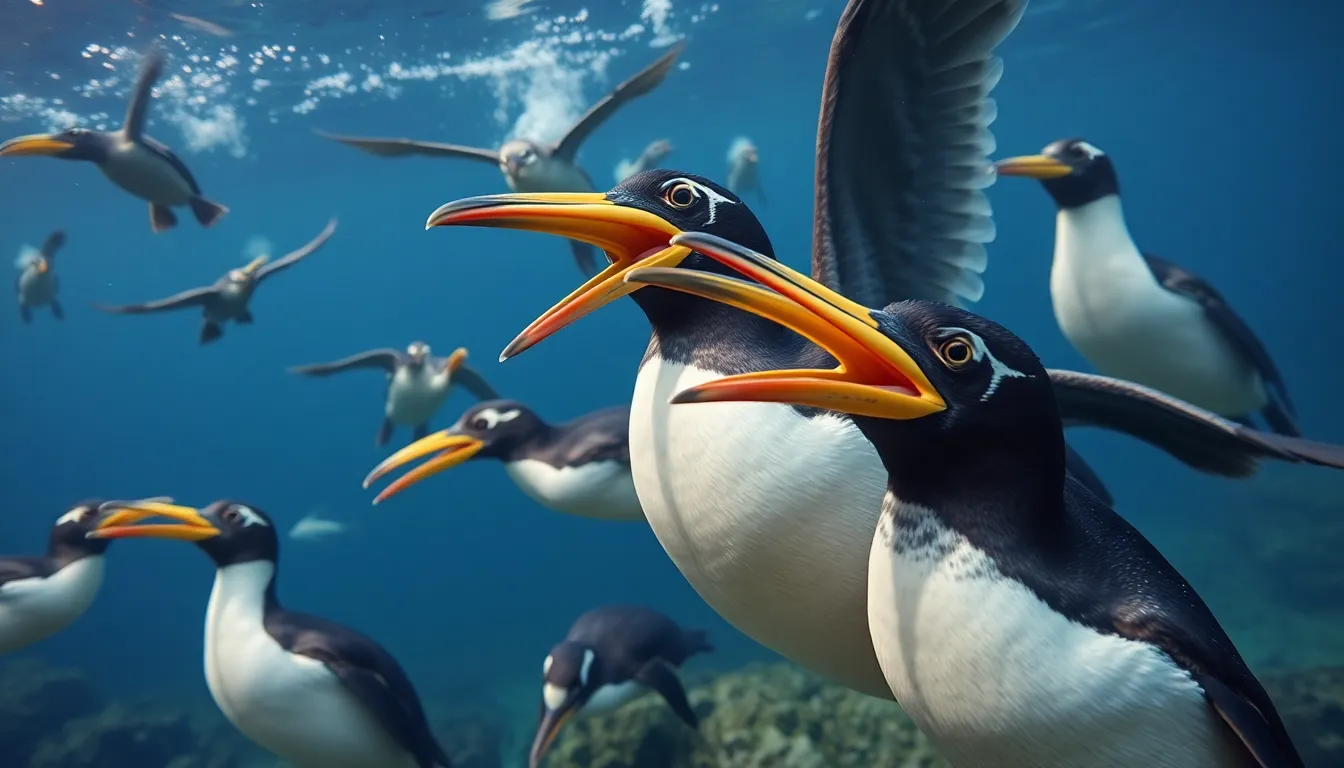
Several diving bird species showcase extraordinary adaptations that demonstrate the remarkable diversity within this specialized group. These species represent different evolutionary approaches to underwater hunting across various aquatic environments.
Penguins: The Ultimate Diving Masters
Penguins represent the most specialized diving birds on Earth with their complete adaptation to aquatic life. Emperor penguins hold the record for deepest bird dives at 564 meters (1,850 feet) and remain submerged for up to 22 minutes during hunting expeditions. Their torpedo-shaped bodies eliminate water resistance while dense bones provide perfect negative buoyancy for effortless descent.
Adelie penguins demonstrate remarkable hunting efficiency by diving to average depths of 45 meters (148 feet) and catching up to 8 fish per minute during peak feeding periods. King penguins showcase endurance capabilities with dives lasting 5-8 minutes while pursuing lanternfish and squid in deep ocean waters. Gentoo penguins excel in shallow water hunting and reach swimming speeds of 36 kilometers per hour (22 mph) when chasing krill and small fish.
| Penguin Species | Maximum Depth (m) | Dive Duration (min) | Primary Prey |
|---|---|---|---|
| Emperor | 564 | 22 | Fish, squid, krill |
| King | 300 | 8 | Lanternfish, squid |
| Adelie | 175 | 6 | Krill, fish |
| Gentoo | 212 | 7 | Krill, fish |
Cormorants and Their Fishing Prowess
Cormorants dominate freshwater and coastal fishing environments through their aggressive pursuit diving techniques. Great cormorants dive to depths of 45 meters (148 feet) and use their webbed feet for powerful underwater propulsion while hunting fish in rivers, lakes, and coastal waters. Double-crested cormorants demonstrate adaptability by thriving in both saltwater and freshwater environments across North America.
Neotropic cormorants showcase precision hunting in shallow waters by diving from surface positions and actively pursuing fish through dense vegetation. These medium-sized diving birds consume up to 1.5 pounds of fish daily and often hunt in coordinated groups to maximize fishing success. Pelagic cormorants specialize in deep ocean diving and regularly descend to 138 meters (453 feet) while hunting rockfish and sculpins along rocky coastlines.
European shags represent the marine specialist branch of the cormorant family and dive exclusively in saltwater environments. Their hunting technique involves rapid descent followed by active pursuit of herring, sardines, and anchovies at depths reaching 61 meters (200 feet).
Loons and Grebes: Freshwater Divers
Loons excel as freshwater diving specialists with their streamlined bodies positioned for optimal underwater maneuverability. Common loons dive to maximum depths of 61 meters (200 feet) and remain submerged for up to 8 minutes while hunting yellow perch, northern pike, and crayfish. Pacific loons demonstrate remarkable endurance with average dive durations of 45 seconds and hunting success rates exceeding 60% in northern lake systems.
Red-throated loons adapt their hunting strategy based on prey availability and typically dive to shallow depths of 3-9 meters (10-30 feet) in smaller freshwater bodies. These Arctic breeding birds consume approximately 200 grams of fish daily during peak feeding periods.
Grebes showcase different diving adaptations compared to loons through their lobed toes and rear-positioned legs. Pied-billed grebes hunt in shallow wetlands and dive to average depths of 6 meters (20 feet) while pursuing aquatic insects, small fish, and amphibians. Western grebes perform spectacular synchronized diving displays and reach depths of 18 meters (59 feet) during cooperative fishing activities.
Great crested grebes demonstrate elaborate underwater hunting behaviors by using their sharp bills to spear fish and amphibians. Eared grebes specialize in diving for aquatic invertebrates and spend 30-40% of daylight hours submerged during migration periods.
Habitat and Distribution
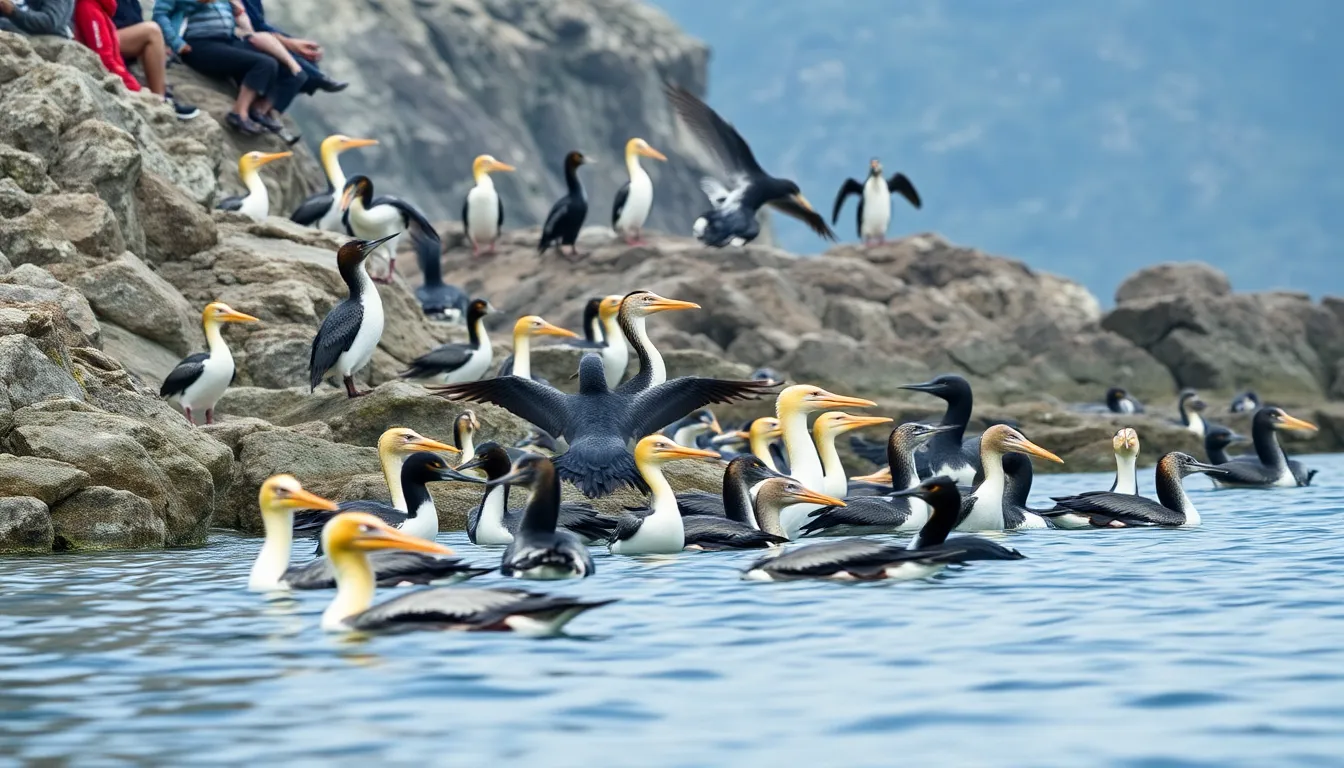
Diving birds occupy diverse aquatic environments across the globe, from vast ocean basins to intimate mountain lakes. Their distribution patterns reflect millions of years of evolutionary adaptation to exact water conditions and prey availability.
Marine Diving Birds
Cormorants establish colonies along coastlines spanning every continent except Antarctica, thriving in both temperate and tropical marine waters. These adaptable hunters frequent rocky shores, coral reefs, and deep oceanic regions where fish populations concentrate. Gannets and boobies dominate tropical and subtropical seas, with Northern Gannets inhabiting North Atlantic coasts while Blue-footed Boobies populate Pacific waters from California to Peru.
Pelican species distribute across warm coastal regions worldwide, with Brown Pelicans favoring Pacific and Atlantic shorelines of the Americas. American White Pelicans migrate between breeding grounds in northern lakes and wintering areas along southern coasts. Penguins occupy Southern Hemisphere waters exclusively, with Emperor Penguins restricted to Antarctic ice shelves and Adelie Penguins establishing rookeries across the Antarctic continent.
Alcids including puffins, murres, and guillemots concentrate in northern Pacific and Atlantic waters where cold currents support abundant fish populations. These seabirds nest on coastal cliffs and islands, diving in nearshore waters during breeding seasons and dispersing across open oceans during winter months.
Freshwater Diving Species
Loons inhabit pristine lakes across northern regions of North America and Eurasia, requiring clear waters with sufficient depth for their specialized diving techniques. Common Loons breed on wilderness lakes from Alaska to Maine, while Red-throated Loons occupy smaller ponds and coastal areas. These birds migrate to coastal waters during winter months when inland lakes freeze.
Grebes populate freshwater habitats across multiple continents, with species diversity peaking in temperate regions. Western Grebes frequent large lakes in western North America, while Great Crested Grebes occupy European and Asian water bodies. Pied-billed Grebes demonstrate remarkable adaptability, inhabiting small ponds, marshes, and slow-moving rivers throughout the Americas.
Diving ducks establish territories on lakes, rivers, and wetlands across temperate zones worldwide. Canvasbacks concentrate on prairie pothole regions during breeding season, then migrate to coastal estuaries and large lakes. Ring-necked Ducks prefer smaller woodland ponds and beaver impoundments, while Redheads occupy emergent wetlands with diverse aquatic vegetation.
Kingfishers distribute along freshwater systems across every continent except Antarctica, with Belted Kingfishers inhabiting streams and ponds throughout North America. These territorial birds require clear water visibility and adequate perching sites near productive fishing areas.
Feeding Behavior and Diet
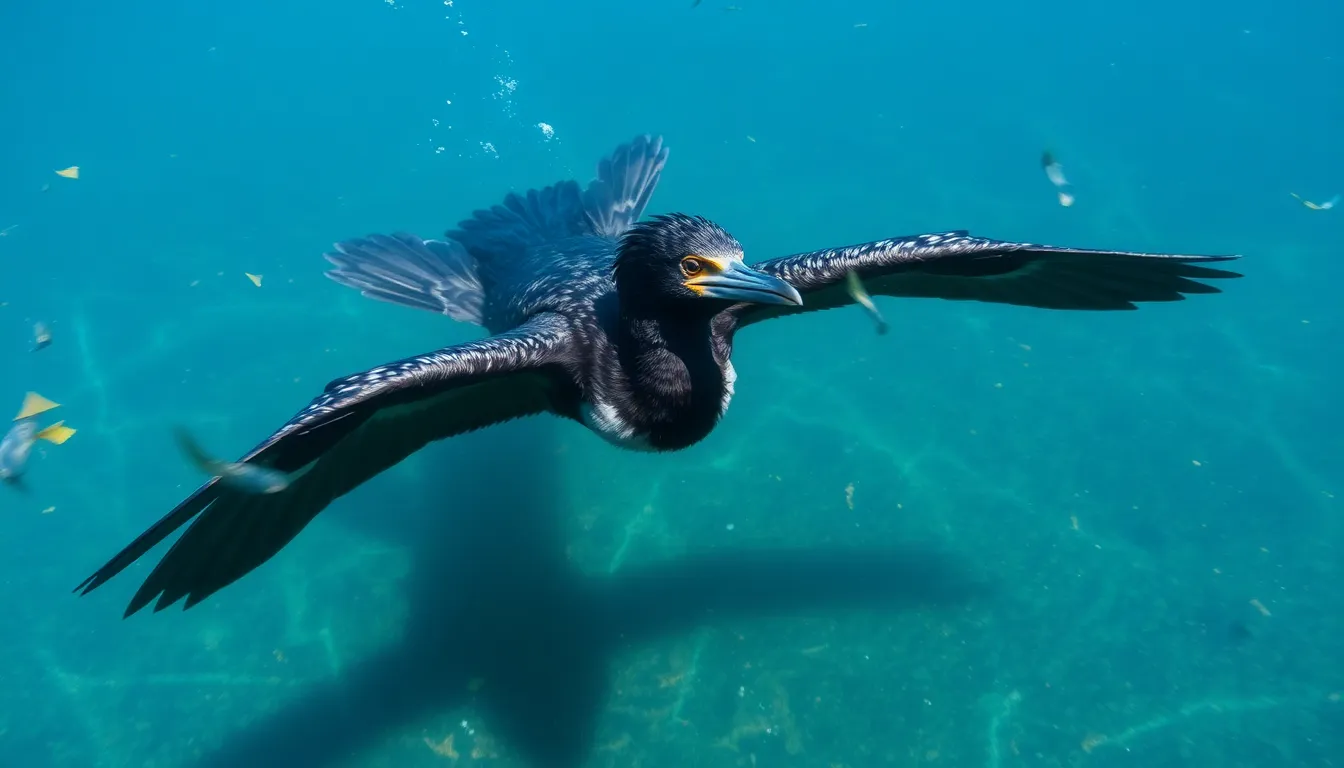
Diving birds employ sophisticated feeding strategies that maximize their hunting success across diverse aquatic environments. We observe these specialized hunters utilizing distinct behavioral patterns that optimize energy expenditure while securing adequate nutrition.
Hunting Strategies Underwater
We find that diving birds execute three primary underwater hunting methods that distinguish them from surface feeders. Visual pursuit dominates among species like cormorants and penguins, which actively chase fish through precise directional changes and bursts of speed. These hunters rely on binocular vision that functions effectively underwater, allowing them to track prey movements within a 15-foot radius.
Ambush hunting characterizes loons and grebes, which position themselves near vegetation or rocky structures before striking unsuspecting prey. We observe these species remaining motionless for 30-45 seconds underwater before launching rapid attacks that cover distances of 6-8 feet in under 2 seconds. Their leg placement posterior to the body center creates powerful propulsion during these critical hunting moments.
Filter feeding represents the most energy-efficient strategy among diving ducks like canvasbacks and redheads. We document these birds creating suction currents that draw small invertebrates and plant matter directly into their bills, processing volumes of 2-3 liters per dive session. Their specialized bill structures contain lamellae that separate food particles from water with 85% efficiency rates.
Prey Selection and Seasonal Variations
We observe diving birds targeting exact prey categories based on seasonal availability and nutritional requirements. Fish constitute 60-80% of the diet for most diving species during breeding seasons, with preferences shifting toward herring, sardines, and anchovies that provide essential fatty acids for egg production.
Breeding season diets emphasize protein-rich selections that support rapid chick development. We document emperor penguins consuming Antarctic silverfish weighing 20-40 grams per individual catch, while cormorants target multiple smaller fish species including smelt and juvenile cod. These hunting patterns coincide with peak fish spawning periods that occur between March and July in northern hemispheres.
Winter feeding strategies shift toward crustaceans and mollusks as fish populations migrate to deeper waters. We observe diving ducks increasing their consumption of amphipods and chironomid larvae by 40% during cold months, diving to depths of 10-15 feet to access these invertebrate populations. Grebes modify their hunting locations during winter, moving from shallow breeding areas to deeper lake regions where crustacean densities reach 200-300 individuals per square meter.
Geographic variations create distinct dietary patterns among the same species across different regions. We find that double-crested cormorants in Pacific coastal areas consume 70% fish and 30% crustaceans, while their Great Lakes counterparts maintain ratios of 85% fish and 15% invertebrates. These adaptations reflect local prey abundance and seasonal migration patterns that influence food chain dynamics.
Conservation Status and Threats
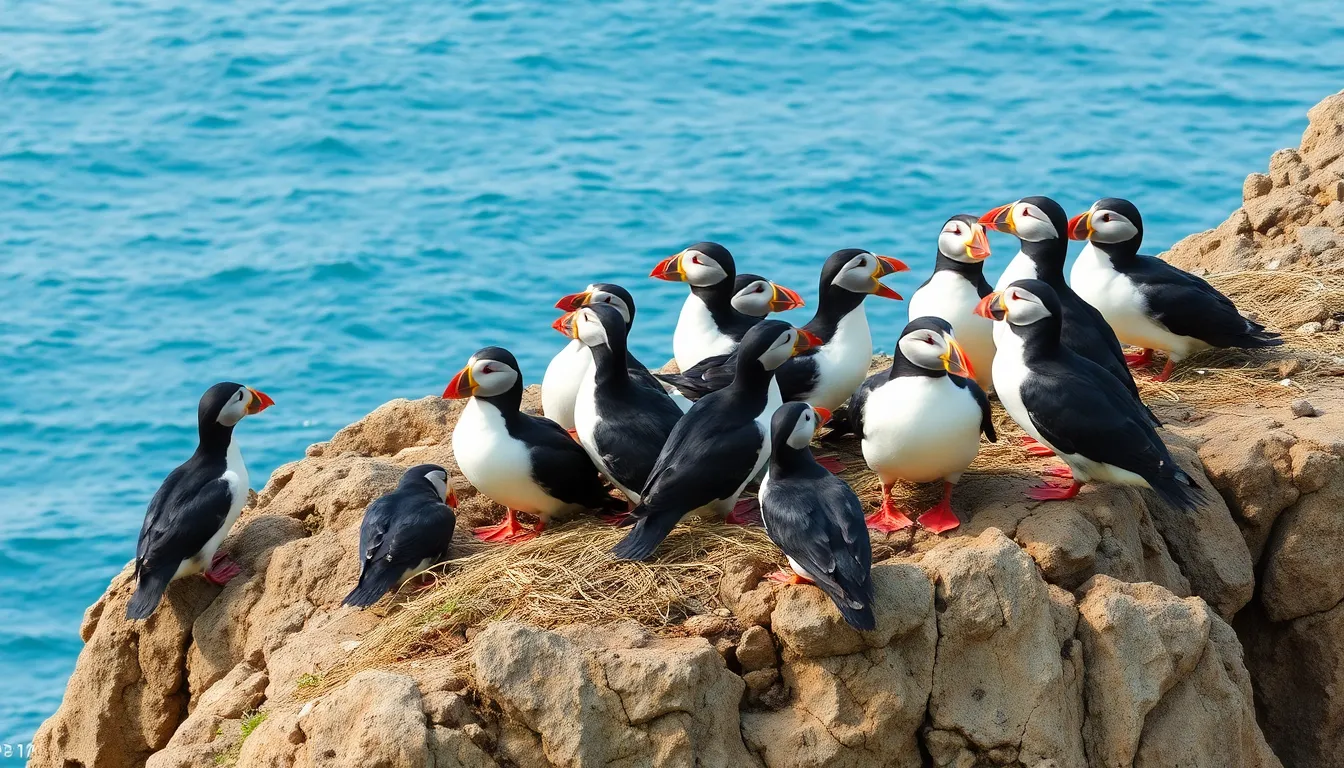
Diving birds face unprecedented challenges across their diverse habitats worldwide. Current conservation data reveals that 32% of diving bird species experience declining population trends due to human activities and environmental changes.
Climate Change Impacts
Rising ocean temperatures fundamentally alter the marine ecosystems that diving birds depend on for survival. Warmer waters cause fish populations to migrate to different depths and locations, forcing cormorants and gannets to expend more energy during hunting expeditions.
Sea level rise threatens coastal nesting sites used by alcids like puffins and murres. Arctic species face the most severe impacts, with emperor penguins losing critical ice platforms essential for breeding colonies. Scientists document that Antarctic ice loss has reduced emperor penguin breeding success by 19% over the past two decades.
Ocean acidification affects the entire marine food chain, reducing prey availability for deep diving specialists. Krill populations decline as acidic waters impact their calcium carbonate shells, directly affecting penguin species that rely on these crustaceans as primary food sources.
Extreme weather events increase in frequency and intensity, disrupting breeding cycles across multiple diving bird species. Storm surges destroy ground nesting sites, while prolonged droughts affect freshwater diving birds like loons and grebes in their breeding territories.
Pollution and Habitat Loss
Plastic pollution poses a direct threat to diving birds through ingestion and entanglement. Marine species mistake plastic debris for fish, leading to internal injuries and reduced feeding capacity. Research indicates that 89% of seabird species, including diving specialists, have plastic particles in their digestive systems.
Chemical contaminants accumulate in diving bird tissues through bioaccumulation in their prey. Mercury levels in loon blood samples exceed safe thresholds in 75% of tested populations across North American lakes. PCBs and other industrial chemicals affect reproductive success by causing eggshell thinning and developmental abnormalities.
Coastal development eliminates critical nesting habitats for marine diving birds. Wetland drainage removes 3.7 million acres of freshwater diving bird habitat annually in North America alone. Urban expansion along coastlines forces diving bird colonies into suboptimal nesting areas with higher predation rates.
Oil spills create devastating impacts on diving bird populations through feather contamination and prey base destruction. Even small oil deposits compromise waterproofing abilities, leading to hypothermia and death. Recovery efforts show that diving bird populations require 5-10 years to return to pre-spill numbers following major contamination events.
Human recreational activities increase disturbance at critical feeding and nesting areas. Boat traffic disrupts diving patterns, while shoreline development reduces available roosting sites for migrating species like grebes and diving ducks.
Conclusion
We’ve explored the remarkable industry of diving birds and their extraordinary adaptations that make them masters of both sky and sea. These specialized hunters demonstrate nature’s incredible ability to evolve answers for survival in challenging environments.
Our journey through their diverse species hunting techniques habitats and conservation challenges reveals just how complex and fascinating these birds truly are. From the record-breaking dives of emperor penguins to the precise strikes of kingfishers each species has carved out its unique ecological niche.
Understanding diving birds helps us appreciate the delicate balance of aquatic ecosystems and reminds us of our responsibility to protect these incredible creatures for future generations to witness and study.
Frequently Asked Questions
What are diving birds and what makes them special?
Diving birds are specialized avian species that have evolved remarkable abilities to hunt and feed underwater. They possess unique physical adaptations including streamlined body shapes for minimal water resistance, dense bones for negative buoyancy, waterproof feathers, enhanced lung capacity, and oxygen-rich blood that allows them to hold their breath for extended periods while pursuing aquatic prey.
Which are the most common diving bird species?
Common diving bird species include cormorants, pelicans, gannets, grebes, loons, kingfishers, penguins, and auks. Each species exhibits unique hunting methods and inhabits different environments – from cormorants in diverse waters to penguins in polar regions, gannets performing high-speed aerial dives, and kingfishers executing precise dives from riverside perches.
How do diving birds hunt underwater?
Diving birds employ three primary underwater hunting methods: visual pursuit (actively chasing prey), ambush hunting (waiting motionless for prey to approach), and filter feeding (straining small organisms from water). Their techniques vary from high-speed aerial dives to graceful underwater pursuits, with each species adapted to specific hunting strategies and prey types.
What’s the difference between surface diving and deep diving birds?
Surface divers like mallards and grebes feed in shallow waters, typically diving just a few feet below the surface. Deep diving specialists such as loons, emperor penguins, and cormorants can reach impressive depths – with emperor penguins holding records for diving over 1,800 feet deep and remaining submerged for up to 22 minutes.
What do diving birds eat and how do their diets vary?
Diving birds primarily target fish, but their diets also include crustaceans, mollusks, aquatic insects, and small marine organisms. Their dietary preferences shift seasonally – fish dominate during breeding seasons while winter diets diversify. Geographic variations also influence diet, with the same species eating different prey in various regions based on local availability.
What threats do diving birds face today?
Diving birds face significant conservation challenges, with 32% of species experiencing population declines. Major threats include climate change affecting water temperatures and sea levels, pollution (especially plastic and chemical contaminants), habitat loss from coastal development, human disturbances, and changes in prey availability due to overfishing and environmental degradation.
Where do diving birds live and migrate?
Diving birds inhabit diverse aquatic environments from oceans to mountain lakes. Marine species like cormorants, gannets, and pelicans adapt to various coastal regions, while alcids such as puffins thrive in northern waters. Freshwater species like loons and grebes have specific habitat requirements and follow distinct migratory patterns between breeding and wintering grounds.
How deep and long can diving birds stay underwater?
Diving capabilities vary dramatically among species. Emperor penguins are the ultimate diving masters, reaching depths of over 1,800 feet and staying underwater for up to 22 minutes. Other accomplished divers include common loons (diving to 200 feet), cormorants (typically 25-80 feet), and various penguin species with impressive diving durations and speeds.




